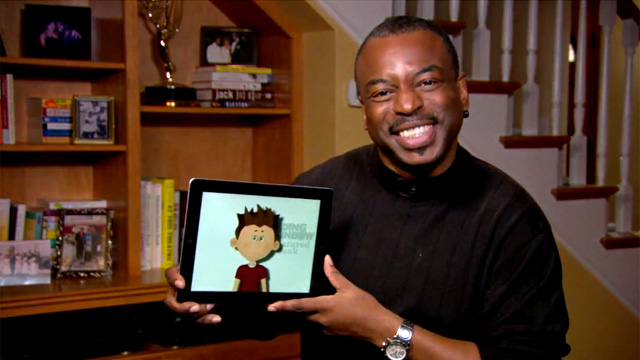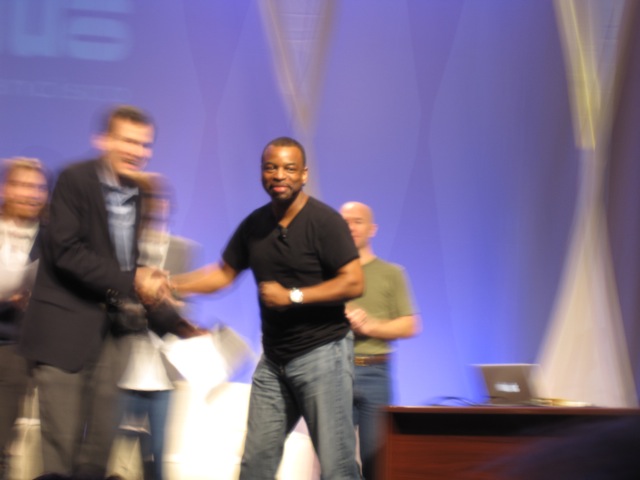
"The mission of Reading Rainbow has always been to use the prevailing technology of the day to steer children toward literature." That's what LeVar Burton—actor, celebrity, and creative force behind the old television classic Reading Rainbow—told Ars on the phone on Thursday. That conversation followed the successful launch of his new Reading Rainbow app for the iPad. But this isn't just some cash grab thanks to the explosion of app stores on mobile devices like the iPad—the launch of the iPad did inspire Burton. He wanted to pursue the app route with his old brand, but the modern Reading Rainbow's roots go back to before the iPad had even hit the market.
Reading Rainbow, the television show, was on the air for 26 years before ending in 2006. PBS eventually stopped running it in 2009 due to a lack of funding, and in February of 2010 at the Macworld Expo in San Francisco, Burton made his first announcement about the future of the brand. At that time, Burton was on stage with New York Times columnist David Pogue, and I was sitting just a few rows back watching the whole spectacle. Burton made mention of Reading Rainbow coming to the Internet; my interest was instantly piqued.
"It was really pretty much born in earnest with that announcement with David Pogue on stage," Burton told Ars. "I have to admit that we didn't know what we were doing back then."

When Burton began talking about the project in those early days, it sounded more like a Web service with videos by Burton and friends—not at all like what we have today with the new iPad app. "That day did begin a journey," Burton said. "We knew we wanted to relaunch Reading Rainbow and we knew it wasn't going to be TV. We were thinking about a virtual world, and then the iPad came out. By the time we brought on our CEO, she came in one day and said, 'I've got it. Books!'"
Indeed, the PBS show didn't expressly sell books, rather they were read to kids through an entertaining and educational television medium. The iPad app, on the other hand, tries to mesh that same level of "edutainment" with actual books that can be browsed and purchased through the app itself. Burton's company has partnered with a number of children's book publishers for the relaunch of the brand, and Burton says the phone has been ringing off the hook with publishers dying to get on board ever since. "If you build it, they will come."
Kids are not reading like they used to
But the medium isn't what's most important to Burton. An iPad app is cool and all (and an Android version is scheduled to launch by the end of the year), but the real goal is to just get kids into reading again. When I asked Burton whether he thinks kids are reading as much today as they were when Reading Rainbow was on PBS, he gave a definitive answer: "No."
"This is one of the reasons it was so important to me, from a personal level, to bring Reading Rainbow to this new generation of kids, to try and do something about it," Burton said. "Here's what I know: in 26 years on PBS, we were able to—through the medium of television—have an impact on the reading habits of children. I want to see if we can make light and do it again."
Burton doesn't think it matters—to kids, anyway—whether they read electronically or on paper. "What matters is that they do read," he said. Part of the goal of relaunching Reading Rainbow on the iPad, as opposed to the Web or another TV show, is that it mimics the feeling of a book while still allowing kids to interact with it in other ways. "I believe tablet computers will continue to become more and more ubiquitous, and their prices will drop," Burton told me. "I love the idea of having it in your hand, in your lap, the way you do a book."
This isn't to say that Burton doesn't believe in traditional books. In fact, he believes strongly in them, and thinks they will only continue to become more precious to us as our culture advances into the digital age. "We will own fewer of them, but the book will never completely go out of style," he said. "I think we have an emotional attachment to it, unlike papyrus or sheepskin or the cave walls, you know? And I could be wrong. We may, in some time, convert completely to some kind of electronic reading device or some kind of medium other than digital. Whatever that next generation is, I don't know."
(At this point in the conversation, I used every last drop of willpower not to make a Star Trek: The Next Generation joke right there on the phone. "E-books will go where no one has gone before!")
What Burton does know is that the iPad has allowed his company to take advantage of the technology of today to reach children. And whatever technology that is at any given point, that's what he wants to pursue. "If a hundred years ago, I was asked to create a way of reaching kids with storytelling through radio, I would have gone for it," he said.
Appealing to adult Reading Rainbow fans—to get to their kids
There are some challenges to resurrecting an old, beloved brand and bringing it to a completely new medium, however. Burton pointed out that many adults are deeply familiar with Reading Rainbow from PBS (and can even sing the theme song from memory—just take a look, it's in a book!), but today's children don't know of the brand at all. As such, there are really two audiences for this relaunched version of Reading Rainbow: parents and children.
"Kids don't know Reading Rainbow, but their parents do, and it can be really tricky to satisfy them both," he said. "If the parent successfully downloads the app for their child and hands the iPad to them, and the child doesn't find it fun or engaging, we've lost. We're talking about two consumer demographics simultaneously."
To that end, the new app is actually much more than an app. There is also a corresponding Web service that is expressly made for parents whose kids are using the iPad app to learn and read. There, parents can get updates on what their kids are reading, how they're progressing through different stages and activities, read blog posts by Burton himself (as well as child education experts), watch clips from the original Reading Rainbow show, and more. "We are creating a community over there for parents to come and share what it's like: the challenges and the triumphs of raising children in this digital age," Burton said.
Talking to Burton, it's clear that the modern version of Reading Rainbow is something he believes in. He says this will remain an active and ongoing project in his life going forward. "There will be new videos, new blog posts, and new content all the time. That's the responsibility you have as a subscription service—you have to continually refresh content," he said. "But we didn't just build an app, we built a company for our kids. We just built an app that made sense in the marketplace. Who knows where it will go after that."
reader comments
61